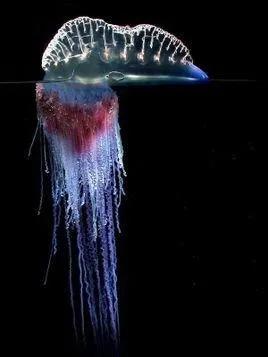The animals introduced today are Physalia physalis from the Pacific Ocean, the Atlantic Ocean, the coast of california in the United States to the sea around Australia, the east coast of the United States to the English Channel and the Mediterranean Sea.

………………………………………………
The secret of floating : they have a floating sac 9-15 cm long, which can be about 15 cm longer when expanded, and there is a special gland in the floating sac that can fill the floating sac with carbon dioxide . The floating sacs then swell , and they float or sink by adjusting the amount of carbon dioxide in the floating sacs. The floating sac has a luminous membrane crown that automatically adjusts the direction, like a sail. Their floating sacs are beautifully pale blue to effectively protect against UV damage.
Deadly poisonous wire: there are long tentacles under the floating sac, up to 22 cm long, with an average length of 10 m.
Monk-hat jellyfish are a class of floating coelenterates that live in groups for life, and they have a clear social division of labor and are very effective. The tentacles have toxin-filled spines that kill small sea creatures. Contracted cells on the tentacles bring prey to the hydra, which surround food and secrete digestive enzymes that break down proteins, carbohydrates and fats.
Although their toxins cause harm to most animals, there are still some animals that are immune to their toxins.
(1) Carangoides bartholomaei
Relationship: Symbiosis, the Bautorolo roe is responsible for attracting prey, and the monk's hat jellyfish is responsible for providing shelter and food scraps.
(2) Double-finned pomfret (Nomeus gronovii)
Double-finned pomfret (juvenile)
Relationship: Parasitic, double-finned pomfret nibbles on the tentacles of the monk hat jellyfish. It also uses tentacles as a shield.
(3) Loygerhead turtle
Relationship: Predator.
Dangerous trampling : Because the monk's hat jellyfish drift along the coast, they are often washed away by the waves. People who come to the coast may have "intimate contact" with them and the consequences can be imagined, as shown in the following figure ↓
So be careful when swimming on the coast!!!
In the end, I hope that everyone can support me. [Prayer] [Prayer] [Prayer]